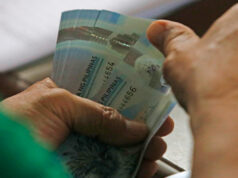Reserves climb for eighth straight month in June
By Karl Angelo N. Vidal, Reporter
GROSS international reserves climbed for the eighth straight month in June, the central bank reported Friday.
Preliminary data from the Bangko Sentral ng Pilipinas (BSP) showed the GIR level stood at $85.379 billion in June, 0.02% higher than the upward-revised $85.358 billion logged in May and up 10.13% from the $77.525 billion recorded in June 2018.
This was the highest reserve level in 23 months or since October 2016 when the GIR stood at $86.139 billion.
The end-June GIR settled above the BSP’s $83-billion projection for the year and the end-2018 level of $79.193 billion.
The central bank attributed the growth in GIR to inflows arising from revaluation gains from the BSP’s gold holdings resulting from the increase in the price of gold in the international market as well as the national government’s net foreign currency deposits.
Apart from these, inflows were also mainly driven by the central bank’s foreign exchange operations and income from overseas investments.
“However, the increase in reserves was tempered by payments made by the NG for servicing its foreign exchange obligations,” the BSP added.
The BSP’s foreign investments — accounting for bulk of the reserves — generated $72.206 billion in June, higher than the $62.356 billion recorded in the same month last year, although lower from the upward-revised $72.479 billion in May.
Meanwhile, the country’s foreign currency stash stood at $2.62 billion last month, lower than the $5.573 billion in June last year as well as the $2.851 billion in May.
A stronger peso usually means losses for the BSP, while a weaker peso pads the GIR.
The central bank uses its reserves to temper sharp swings in the exchange rate.
The BSP’s gold holdings stood at $8.855 billion in June, up from $8.332 billion in May and $7.913 billion in the same month last year, reflecting improved gold valuations in the international market.
Reserves maintained under the International Monetary Fund (IMF) dropped 0.6% to $523.4 million in June from $520.6 million in May.
Special drawing rights — or the amount which the Philippines can tap under the IMF’s reserve currency basket — were at $1.175 billion last month, steady from May’s downward-revised figure.
The current level, which the BSP said “serves as an ample liquidity buffer” can cover up to 7.4 months’ worth of import duties and is equivalent to 5.1 times of the country’s short-term external debt based on original maturity, and 3.7 times based on residual maturity.
On the other hand, net international reserves, which refers to the difference between the BSP’s GIR and short-term liabilities, likewise increased to $85.36 billion as of end-June from $85.34 billion recorded in May.
Nicholas Antonio T. Mapa, economist at ING Bank N.V.-Manila, said the GIR climbed to back to its pre-2018 level as the central bank slowly rebuilds its buffer stock of foreign currency.
“Quickly rebuilding its defenses after a substantial drawdown in 2018, the BSP now boasts a formidable cache of reserves to fend off any speculative attack on the currency,” Mr. Mapa told reporters in an e-mail on Friday.
He added that the buffer stock shows the country can “repay all foreign currency obligations due within the next 12 months, almost five times over.”
“With the GIR defenses rebuilt and the Philippines standing tall after taking the worst that the global headwinds could throw at it, BSP would be wise to simply carry out cursory presence in the FX (foreign exchange) spot market and utilize monetary policy for its real directive: price stability conducive for robust economic growth,” Mr. Mapa said.



